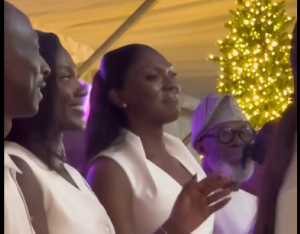Every five minutes the line grew longer and longer spilling to the street outside of the Chapel on Manger Square.
What are the people thronging in for? Is there a special sermon going on that they want to listen to? Or there is there a special religious activity that they wanted to participate.
The entrance to the main auditorium is not much wide for people to rush in so what is happening I crave for answers.
“Over there look, that is the Church of Nativity where Jesus Christ was born over two thousand years ago” my tour guide pointed to me.
Oh yes! I am in Bethlehem, the city of bread, the Holy City where Jesus Christ was born over two thousand years ago. Whew!
Crossing Gilo border from Israel to Bethlehem which is under [Palestinian Authority], recently was as easy as any exercise I have ever done in my life.
Apart from gun wielding Israeli border security officers who were manning their side of the border check point, not a single soldier from the Palestinian side was spotted manning their side of the border.
After the free movement of tourists, pilgrims, visitors and holiday makers across the border, I stood still for a while, heave a sigh of relief, turn round and asked where the security personnel are?
Wondering where I was, I turned around again and looked at the tall concrete wall that separates Palestine from Israel, the long cross border security tunnel and realized, “Oh yeah I am in Bethlehem and now under Palestinian control”.
The hospitality of the people in the city, the beautiful ancient but well maintained manger baby Jesus was put, the gift of the three wise men and the shining star on the spot where the saviour Jesus Christ of Nazareth was born, called me to visit Bethlehem, the city of Bread for the second time.
Infectious smiles on the faces of Palestinian commercial drivers just over the border check point, who are always ready to help tourist, visitors, pilgrims and holiday makers will always make one to return for a visit.
So for me twice a Jerusalem Pilgrim [J.P], it was not surprising to cross the border to the city only to be mobbed by commercial drivers who asked me where I was going and how they could help me.
“Where are you going and how can I help. Please come and let me take you to your destination. Do not be afraid, I will treat you nice because you are in safe hands were the welcome message” I received from these kind Palestinian drivers.
Among the several drivers who came to my side, Mohamad a taxi driver got the green light from his cousin and drove me from the border check point to Bethlehem Bible College [BBC] which was not far from the church of Nativity where Jesus Christ was born in a cave over 2000 years ago.
Tourists, holiday makers and visitors who were not aware they were in Bethlehem because they did not see heavy security at that time came to themselves later and were not barred from either visiting the Church of Nativity, Jesus birth place as well as other equally important places like chapel of St. Catherine, shepherds fields, Church of Milk Grotto, the manger square market, Rachel tomb and Herodion.
Joy filled my heart when through my good Samaritans I contacted my hosts Dr. Bishara Awad and Dr. Salim J.Munayer, both from the Bethlehem Bible College [BBC] in Palestine.
Bethlehem Bible College [BBC] which was solely founded in 1979 by Dr. Bishara Awad, a Palestinian, exists to train people to serve Christ in the world, advocate a Palestinian evangelical perspective and model Christ through community development in the city of Bethlehem, a Palestinian controlled territory.
The lord used Dr. Bishara Awad, to start the light for him with a gift of 20 dollars from a local pastor and the college have four buildings well equipped with 150 students being trained to become pastors, church leaders, Sunday school teachers and educators and the college is fully recognized by the Palestinian Authority, Ministry of Higher Education.
After a wonderful tour of the Bethlehem Bible College led by the founder Dr. Bishara Awad, who is now on retirement, we visited the Church of Nativity, the birth place the birth place of Jesus Christ of Nazareth which took place over two thousand years ago.
A lot has changed at the Church of Nativity as the whole place is currently undergoing a massive renovation but the power and joy at the spot where the saviour was born, the manger, in which baby Jesus was put and the gifts from the three wise men could still be felt with the blue haze indicating the presence of the Holy Spirit.
Long queue was expected at the birth place but not at the time where the city was not celebrating the birth of Jesus Christ of Nazareth at the cave in the church of Nativity in Bethlehem in Palestine.
The little town of Bethlehem, which in Hebrew means “city or house of bread”, has many biblical associations reflecting a tranquil, pastoral existence.
As its name signifies, in antiquity the district was known for its fields and terraces. In the old Bethlehem, is often referred to as Ephrat, which means fruitfulness.
Here nearly four thousand years ago, Jacob buried his young wife Rachel; here was the home of Naomi and her family; here Ruth gleaned in the fields and fell in love with her kinsman Boaz; here their great-grandson David was born and here Samuel “anointed him in the midst of his brethren”[1Samuel 16:13].
But the event which took place here and transformed the course of history was that “Jesus was born in Bethlehem of Judea” Mathew 2; 1. Today, this town, surrounded by a beautiful hilly landscape, is the home of Christians and Muslim Arabs, many of whom are skilled artisans and craftsmen.
CHURCH OF NATIVITY
Luke 2:7 describes how Mary “brought” forth her first born… and laid him in a manger; because there was no room in the inn. Over this cave-like manger, traditionally Jesus birth place, rose the Basilica of the Nativity.
From the very beginning of the Christian era this was a sacred grotto, above which in the fourth century, Emperor Constantine constructed a large church, first piercing a hole in the cave roof for the faithful to look down into the Holy place, then erecting an Octagonal alter over it.
The altar is still there. Around two hundred years later, Emperor Justinian rebuilt the Basilica much as it is seen today, and put up a mosque pediment of the Magi in Persian dress.
Because of this picture, it is claimed, the church of the Nativity from destruction. No basic changes were made by the crusaders except for the decoration of the church with rich paintings and glass mosaics.
The entrance to the Basilica of the Nativity, which is shared by the Armenians, the Greek orthodox and the Latins has been filled bellow the straight wide Byzantine lintel to outline the pointed crusader doorway.
This in turn was partially blocked by the Turks, leaving the present opening small to allow for easy defence and prevent horses and other animals from entering the church.
The rectangular prayer hall is approximately 200 by 90 feet, with four rows of twelve brown Bethlehem stone pillars. The oak ceiling was donated by Edward IV of England and Duke Philip of Burgundy in 1482.
There is a pink marble font to the right and the original eight sided altar directly ahead.
In the floor are trapdoors through which remains of the mosaic floor of the original church can be seen.
Curved steps descend to the Grotto, where a silver star overlies the spot of Jesus birth.
It bears the Latin instruction “Hic de virgine Maria Jesus Christus natus estt-1717” –here Jesus Christ was born of the virgin Mary-1717. Nearby, is the chapel of the Manger, which belongs to the Greek orthodox, Mary is said to have laid the child Jesus Christ.
CHAPEL OF THE ST. CATHERINE
Adjacent to the church of the Nativity is the Franciscan Chapel of St. Catherine of Alexandra, sensitively restored by Antonio Barluzzi in 1933. From here, Bethlehem’s annual midnight mass on Christmas is broadcast all over the world.
A statue of the St Jerome, who lived here in the fifth century and translated the Bible into Latin, stands in the middle of the courtyard, interesting crypts, said to be the burial places of St. Jerome, St Paula and St. Ensebius of Cremona, honey comb the rock.
Another door, always kept locked, links the crypt with the Grotto of the Nativity. Within the church of St. Catherine are the Chapel of St. Joseph where Joseph was commanded by an angel to flee to Egypt and the chapel of Innocents, commemorating the massacre of the babies killed by Herod.
SHEPHERDS FIELDS
Shepherds still pasture flocks around Bethlehem, where the shepherds heard the good tidings of Jesus birth from the angel of the Lord who told them to go to Bethlehem to adore the child [Luke 2].”Shepherds field”, sometimes called Ruth’s field, is near the village of Bet-Sehur.
Everywhere, evidence is found of Byzantine convents and a Greek orthodox church, covers a cave which has a fire fourth century mosaic floor.
Another church, called “Campo Dei Pastori”-“Shepherds Field” was rebuilt for the Franciscan by Antonio Barluzzi in 1950.
The design of the church represents a shepherd’s tent and the light penetrating the church through the glass openings of the dome recall the light that shone on the shepherds when angel appeared to give them the tidings of Jesus birth.
The walls are decorated with frescos depicting the story of the shepherds and in the center of the church is an altar supported by bronze statues of the shepherds.
CHURCH OF THE MILK GROTTO
The milky white church of the Milk Grotto is a Franciscan Chapel built over the cave in which the Holy Family sheltered during the flight to Egypt. When King Herod heard from the three wise men that the new born King of the Jews had been delivered or born in Bethlehem, he ordered all male children aged two years and less to be killed.
An angel warned the Holy Family of these murders, and they fled to Egypt. Tradition holds that while nursing the baby, some of the Mary’s Milk spilled on the stone floor, turning the entire cave white.
Packets of the powdered white stone are sold there and are especially popular with nursing mothers who believe that the powder will ensure a plentiful supply.
After fruitful discussions with my hosts, a tour of these places of Christ, I enjoyed lunch in Bethlehem and headed back to Jerusalem.
It was really an experience having visited Bethlehem on September 09, 2017 where there was no hurling of stones by Palestinians at Israeli soldiers or tooting of guns by Israeli soldiers at Palestinians which created an imaginary scene of peace and how the world would have been lovely with it.
Opinions of Friday, 29 December 2017
Columnist: Stephen A.Quaye















